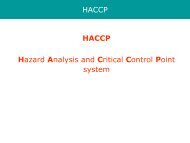Disaster Risk Management Strategy and Plan of Action - Caribbean ...
Disaster Risk Management Strategy and Plan of Action - Caribbean ...
Disaster Risk Management Strategy and Plan of Action - Caribbean ...
You also want an ePaper? Increase the reach of your titles
YUMPU automatically turns print PDFs into web optimized ePapers that Google loves.
Regional <strong>Disaster</strong> <strong>Risk</strong> <strong>Management</strong> <strong>Strategy</strong> for the Tourism Sector in the <strong>Caribbean</strong> – Final<br />
(UNISDR 2009)<br />
Hazard, <strong>Risk</strong> <strong>and</strong> Vulnerability Assessment (HRVA)<br />
A process to determine the level <strong>of</strong> risk given a vulnerability to a hazard. Synonymous with <strong>Risk</strong> Assessment defined<br />
below <strong>and</strong> widely referred to as HVA (Hazard Vulnerability Assessment) in the <strong>Caribbean</strong> region. HRVAs are<br />
undertaken at all levels with corresponding degrees <strong>of</strong> specificity.<br />
HRVA Tool<br />
A tool to assist in conducting a hazard vulnerability <strong>and</strong> risk assessment. There are a variety <strong>of</strong> tools available for the<br />
conduct <strong>of</strong> hazard, vulnerability <strong>and</strong> risk assessments at various levels. The most common focus is on the<br />
community level, where HRVAs are conducted in an all-hazard context to assist in determining the relative risks<br />
posed by a variety <strong>of</strong> hazards to which the community may be vulnerable.<br />
Mitigation<br />
The lessening or limitation <strong>of</strong> the adverse impacts <strong>of</strong> hazards <strong>and</strong> related disasters.<br />
Comment: The adverse impacts <strong>of</strong> hazards <strong>of</strong>ten cannot be prevented fully, but their scale or severity can be substantially lessened<br />
by various strategies <strong>and</strong> actions. Mitigation measures encompass engineering techniques <strong>and</strong> hazard-resistant construction as well<br />
as improved environmental policies <strong>and</strong> public awareness. It should be noted that in climate change policy, “mitigation” is defined<br />
differently, being the term used for the reduction <strong>of</strong> greenhouse gas emissions that are the source <strong>of</strong> climate change.<br />
(UNISDR 2009)<br />
Natural hazard<br />
Natural process or phenomenon that may cause loss <strong>of</strong> life, injury or other health impacts, property damage, loss <strong>of</strong><br />
livelihoods <strong>and</strong> services, social <strong>and</strong> economic disruption, or environmental damage.<br />
Comment: Natural hazards are a sub-set <strong>of</strong> all hazards. The term is used to describe actual hazard events as well as the latent<br />
hazard conditions that may give rise to future events. Natural hazard events can be characterized by their magnitude or intensity,<br />
speed <strong>of</strong> onset, duration, <strong>and</strong> area <strong>of</strong> extent. For example, earthquakes have short durations <strong>and</strong> usually affect a relatively small<br />
region, whereas droughts are slow to develop <strong>and</strong> fade away <strong>and</strong> <strong>of</strong>ten affect large regions. In some cases hazards may be coupled, as<br />
in the flood caused by a hurricane or the tsunami that is created by an earthquake.<br />
(UNISDR 2009)<br />
Preparedness<br />
The knowledge <strong>and</strong> capacities developed by governments, pr<strong>of</strong>essional response <strong>and</strong> recovery organizations,<br />
communities <strong>and</strong> individuals to effectively anticipate, respond to, <strong>and</strong> recover from, the impacts <strong>of</strong> likely, imminent<br />
or current hazard events or conditions.<br />
Comment: Preparedness action is carried out within the context <strong>of</strong> disaster risk management <strong>and</strong> aims to build the capacities<br />
needed to efficiently manage all types <strong>of</strong> emergencies <strong>and</strong> achieve orderly transitions from response through to sustained recovery.<br />
Preparedness is based on a sound analysis <strong>of</strong> disaster risks <strong>and</strong> good linkages with early warning systems, <strong>and</strong> includes such<br />
activities as contingency planning, stockpiling <strong>of</strong> equipment <strong>and</strong> supplies, the development <strong>of</strong> arrangements for coordination,<br />
evacuation <strong>and</strong> public information, <strong>and</strong> associated training <strong>and</strong> field exercises. These must be supported by formal institutional,<br />
legal <strong>and</strong> budgetary capacities. The related term “readiness” describes the ability to quickly <strong>and</strong> appropriately respond when<br />
required.<br />
(UNISDR 2009)<br />
Prevention<br />
The outright avoidance <strong>of</strong> adverse impacts <strong>of</strong> hazards <strong>and</strong> related disasters.<br />
Comment: Prevention (i.e. disaster prevention) expresses the concept <strong>and</strong> intention to completely avoid potential adverse impacts<br />
through action taken in advance. Examples include dams or embankments that eliminate flood risks, l<strong>and</strong>-use regulations that do<br />
ix

















